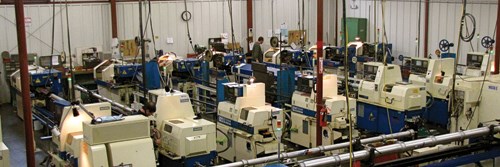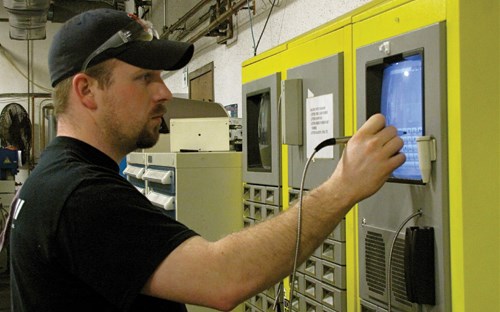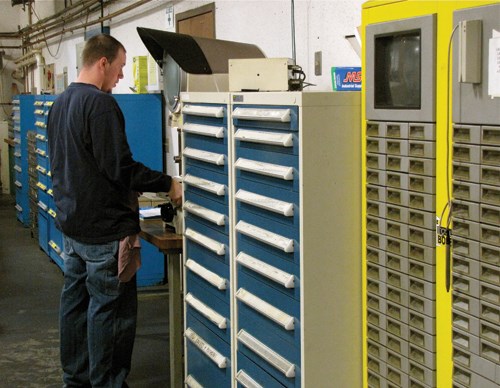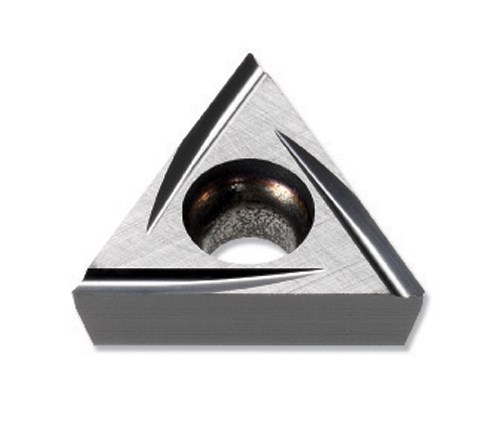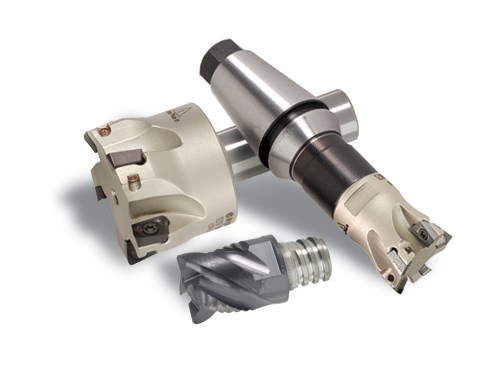Selecting and sourcing appropriate cutting tools for almost 60 fully-utilized CNC machine tools is a large task that the owners of Swissline Precision Manufacturing (Cumberland, R.I.) recognize as a major contributor to its bottom line. The 30,000-plus square-foot job shop turned out more than 2.5 million medical, aerospace, energy and other high precision components in 2009. It works with a range of materials from brass and stainless steel to harder-to-machine materials, including titanium, Inconel and plastics.
Cutting tools account for a significant portion of the company’s annual expenses, behind capital investments in CNC equipment, according to Mike Chenevert, manufacturing engineer at Swissline. The company has 48
Tsugami Swiss-type machines and four Okuma lathes on the shop floor, in addition to other manufacturing technology.
To help achieve the optimal balance between high productivity and low machining costs, the company aggressively manages its consumption and purchases of cutting tools. It has developed a network of reliable external suppliers and a system of internal practices to address its needs.
Seeing the Forest Through the Trees
“It’s easy to become completely overwhelmed with the number and variety of cutting tools and tooling options on the market,” Mr. Chenevert
says. “I spend time every day reading about cutting tool technology and researching the latest improvements.”
Mr. Chenevert shares his ideas for improving productivity with his father, company president Dave Chenevert, and Gerard Hester, plant manager. He recommends cutting tool purchases when new jobs necessitate tooling that is different than what is stocked in-house, or when inventories of standard tooling drop below desired levels.
Keeping universal and frequently used cutting tools on hand is one of the lean manufacturing practices that Swissline adopted in order to reduce downtime between job change-overs and unexpected crashes. Stock tooling is stored in a computerized system that automatically tracks inventories as operators log in and check out necessary tooling. It generates a re-order notice to Mr. Chenevert when inventory levels fall below a preset minimum that varies per item, helping minimize the company’s investment in idle tooling.
“Whenever we can, we specify cutting tools that can be used in multiple jobs and added to the tooling inventory system,” Mr. Chenevert says. “It’s easier to be more responsive to new job requests and competitive in our quoting if we already have the tooling we need to get a job done, too.”
Keeping Track
At breakdown of a job, the machine operator packs all job-specific cutting tools, along with the part print, tool layout and other important details, into kits that are labeled, organized and stored by customer account and job number. Besides helping reduce setup times for its many contracted jobs and blanket orders, the practice helps Swissline keep track of its valuable inventory of cutting tools. Upon breakdown, the operator also performs an inspection of all used tooling which, when combined with the machine’s software generated reports of tool usage, may prompt another request for replacement tooling.
Mr. Chenevert considers the direct and indirect costs associated with cutting tools when he evaluates new and replacement purchases. Some considerations are quantifiable: parts per edge, number of cutting edges, feeds and speeds, range of finish, and ability to meet and repeat tight tolerances.
Indirect costs include the frequent change-overs and added downtime associated with tools that perform fewer operations or offer fewer cutting edges. With simpler cutting tools and frequent change-overs, there are more chances to adversely affect part quality, too.
Balancing Act
There are times when buying less expensive tools with simple geometries or molded cutting tools with lower graded coatings makes great sense, according to Mr. Chenevert, but paying for extra functionality or ground stick tooling when neither adds value to the job reduces the competitive advantage needed when quoting work.
“The balance between quality and cost varies per job,” Mr. Chenevert says. “We do use less expensive stick tools on some of our smaller, more intricate parts. We can get closer to the guide bushing and have less deflection.”
For re-orders of frequently used cutting tools, Mr. Chenevert often compares prices in distributor catalogs and online, while also considering minimum order requirements and shipping time. Low per-unit cost is of little value if minimum order requirements are too high or delivery is slow and unreliable. Having enough cutting tools in inventory to maintain ongoing production levels, replace tooling that breaks unexpectedly or meet short deadlines for new jobs without accumulating a large supply of non-performing assets is the goal. With the number of jobs and size of job runs down since 2008, Swissline monitors its consumption and purchasing of cutting tools more carefully.
Bringing in the Pros
Despite efforts to minimize the variety of cutting tools used in its machines, many of Swissline’s jobs require specialized tooling or even custom tooling. That’s when Mr. Chenevert calls upon his network of suppliers to learn more about new products on the market. Especially when quoting a new job requiring complex machining processes, finding the most cost-effective and highly productive cutting tools can make the difference between winning and losing the job.
Chenevert has cultivated solid relationships with representatives and distributors of cutting tools from several companies, including Iscar, Kennametal and
Ingersoll Cutting Tools. With an impressive background knowledge that he maintains by reading trade publications, reviewing supplier catalogs, attending industry trade shows and manufacturer- or distributor-sponsored seminars, Mr. Chenevert often knows where to start looking when he needs a new, advanced cutting tool.
He often will contact his cutting tool distributor first, but is not timid about calling the manufacturer directly and asking to speak with one of the product specialists or engineers on staff. Mr. Chenevert highly values any distributor rep with both general industry and product specific knowledge. He is naturally inclined to work with someone who fluently speaks “shop talk.”
An Example
After attending an educational seminar about cutting tools, presented by Ingersoll at The Robert E. Morris Company in 2009, Chenevert asked the regional Ingersoll product specialist, David Fazzina, for more information about specific products that piqued his interest. The company’s innovative ChipSurfer line of milling tools and key cutters and its Mini-Turn shanks with easily replaceable inserts are some of the products that Swissline has since tried and continues to use.
“We studied the types of parts that they run, the average depths of cut they take, the materials they run, and the speeds they were running at,” Mr. Fazzina says. “We brought in a variety of turning inserts for Swissline to try until it achieved measurable success with a product called Mini-Turn.”
Mini-Turn inserts are ground to the smallest of tolerances, which gave Swissline repeatability during tool changes. The inserts held up well against a variety of materials, lasted longer and were more accurate. Of course, they cost about twice as much as their molded counterparts, too. Mr. Chenevert carefully weighed the benefits of these new inserts before deciding to add them to his cache of cutting tools. “I am happy with the improvements in quality and tool life, relative to the increased cost,” he says.
Swissline found similar success with Ingersoll’s new ChipSurfer line of milling tools and key cutters. The product replaces a conventional cutting tool that relies upon use of an ER collet, separate shank and replaceable inserts. Using this cutting tool, Swissline can quickly switch end mill tips and achieve repeatability within 0.0005 inch. Time spent recalculating offsets or retouching off tools is also significantly reduced. High metal removal rates combined with improved tool life and the elimination of chatter are additional benefits Swissline realized.
Tap All Resources
“I give credit to my local tooling distributor, E.M. Benson, for inviting me to the Ingersoll event at The Robert E. Morris Company,” Mr. Chenevert says. “Understanding how inserts work helps me evaluate different tooling. I’d tell any shop owner to use all the educational resources available and to call your distributors or manufacturers directly if you have a question. Don’t overlook the application engineers who work with your brands of machine tools, too. They have a large bank of experience when it comes to selecting tooling.”
Finding a product that performs as advertised is not always the case, Swissline has learned. Through trial and error, it has experienced its share of disappointments with cutting tools that failed to hold up as long as expected or deliver the tolerances promised.
Since reprioritizing the role of cutting tools in making job margins, the company has made a conscious effort to take advantage of some of the industry practices that they previously overlooked. In the past, they received free trial tooling but often let it sit idle or failed to provide sufficient follow up to the supplier.
Now, when Mr. Chenevert homes in on the new cutting tool that he wants to try, he will ask for a free trial. In exchange for the valuable information he returns to the cutting tool companies, the supplier usually readily agrees. The benefit is mutual: Swissline eliminates the upfront cost of buying advanced or experimental cutting tools in the upper limits of its usual price range, and the manufacturer receives accurate reports of the tool’s true-to-life performance afterwards, as well as a foot in the door to conduct repeat business with Swissline.
The number and variety of its jobs have resulted in the acquisition of an impressive library of cutting tools. In the next few months, Swissline will move its files of customer tool kits and change the layout of its shop floor to accommodate the addition of a centrally located “tool crib.” A tool crib manager will oversee the large inventory of cutting tools and dispense job specific tooling to machine tool operators.
“There are so many new ideas and designs for tooling,” Mr. Chenevert states. “Finding the right tooling for the application is challenging, but possible if you do your homework, ask questions and are willing to experiment.”
Keeping current with manufacturing trends and technologies requires time and a tireless desire to stay ahead of the competition. Swissline’s manufacturing capabilities are virtually unlimited today as a result of the company’s smart investments in machine tools and related tooling that produce volumes of diverse, competitively priced and high quality parts.


